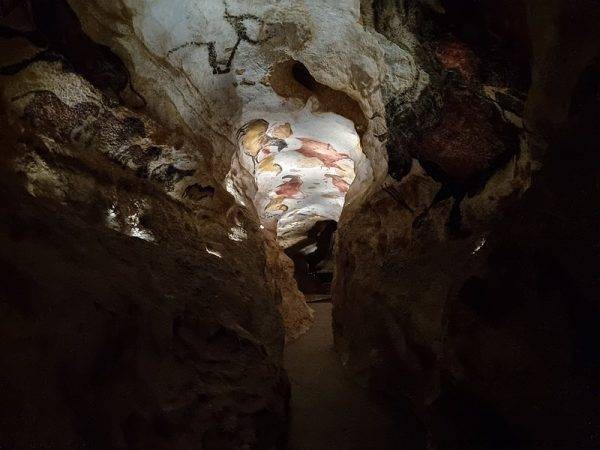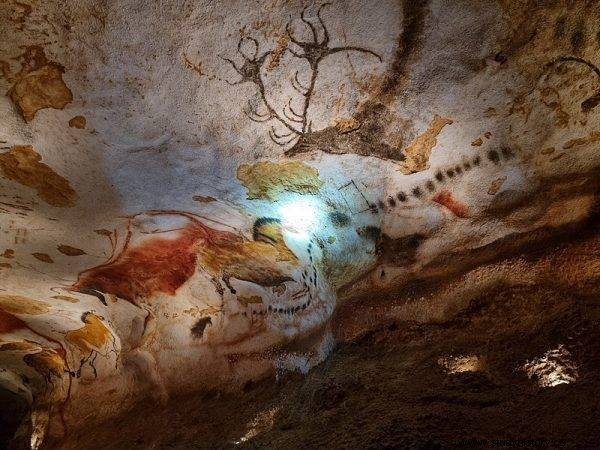Paintings from Lascaux dating back as far as 15,000 BC. they are the finest known example of Palaeolithic art. They were discovered by accident.
Today, hundreds of people come to a small town in France just to see ... a faithful copy of the famous Lascaux paintings.
Discovered by accident
The year is 1940, autumn storms are raging in Aquitaine. During one of them, an old tree falls over near Montignac, revealing a hole. Some time later, eighteen-year-old Marcel Revidat goes for a walk. Unexpectedly his dog Robot discovers a hole that looks like a foxhole at first glance. In fact, turns out to be the entrance to a prehistoric gallery. A story like a fairy tale? More than you might imagine. For many years this is what the most popular version of events sounded like. Today, hardly anyone mentions the dog, and on the official website of the Lascaux cave you can read that it was Marcel who discovered the mysterious hole. As he was unable to investigate it himself, he enlisted the help of three colleagues - Jacques Marsal, Georges Agnel, and Simon Coencas.

Abbe Breuil in the Lascaux Grotto
At first, teenagers thought they had discovered a medieval tunnel leading to the remains of a nearby castle. But the truth was more surprising. After descending into the depths, more paintings appeared. Initially, they planned to keep the discovery to themselves and not tell anyone about it . Ultimately, however, they notified their teacher. The latter gave unusual news to Henri Breuil , who lived nearby. - a Catholic priest, a professor in archeology, geology and anthropology. It was he who created the first, very accurate drawings showing the cave and the paintings discovered in it.
Craftsmanship of Paleolithic Artists
In a 30-meter-deep cave, less than a quarter of a kilometer long, there are over a hundred paintings from various periods , as well as over a thousand rock carvings. Historians usually define their age as the middle of the Magdalenian culture, that is, around 18,000–15,000. years BC Interestingly, the paintings were not created at the same time. By observing them, one can easily trace the development of Palaeolithic painting.

Palaeolithic painters covered with art not only the walls and ceilings of the chambers, but also the corridors connecting them.
Palaeolithic painters used the possibilities of the cave to the limit, covering with art not only the walls and ceilings of individual chambers, called offices, but also the corridors connecting them . The largest of the rooms is the so-called Bull Hall (20 by 10 meters and as much as 5 meters high), which owes its name to images of these animals, several meters high. Painted with a black outline and filled with colorful spots, they make a great impression. Additionally, their creator applied a procedure that today in art is called shortened perspective - the bull is presented in profile, but its horns are shown frontally. The vividness of the paintings is so delicate that when you look at them, you can get the impression of three-dimensionality.
The theme of the paintings
Bulls are not the only animals depicted on the rock walls of the Lascaux Cave. There are also horses, deer, bears and also lions. For the latter, Paleolithic artists dedicated a separate room "baptized" by archaeologists with the Cabinet of Cats. This room is considered to be the heart of the cave.
Another interesting fragment of the French grotto is the room located in its lowest parts, called the Well by scientists . On its wall there is another proof of the maturity of the art of Palaeolithic artists - the narrative scene . The human figure (rarely seen in prehistoric art) is depicted with a phallus and a bird's head lying down. It's probably a hunting scene. There is a javelin next to it, and a bit further there is a buffalo with guts flowing out of its belly.
Paleolithic techniques
The discovery of the Lascaux cave allowed to answer many questions about ways of creating art thousands of years ago . In the mentioned Cabinet of Cats, Palaeolithic painting and engraving tools were found as well as lamps made of sandstone. In many places, where the paintings are higher, you can also see traces of the beams, which were probably a kind of scaffolding. Inside, cut animal skins have survived for thousands of years as templates for painting, as well as bones (e.g. bison blades), on which dyes were probably rubbed.

We can find horses, deer, bears and also lions there.
And what did the artists in the Paleolithic paint? They used natural paints made of ocher or charcoal with water as the binder. The lack of organic ingredients in the composition of paints makes it impossible to accurately determine the age of each show . In creating their works, prehistoric painters used brushes made of animal hair, moss and even bones. There are also theories that in some cases the pigments were blown out like a tube through the hollow bones.
For selected only
Today, it is virtually impossible to see the Lascaux Grotto live. For many years, only a handful of scientists in special suits have access to its interior. And not more often than a few times a year, for no longer than 40 minutes. Forgotten and devoid of air circulation the cave and its paintings are in excellent condition - until. Since it was opened to the public in 1948, over a thousand people have viewed it every day.

Today it is virtually impossible to see the Lascaux Grotto live.
Unfortunately, the increased concentration of carbon dioxide exhaled by tourists, as well as the microbes and bacteria they carry, quickly led to the appearance of fungi. Many of the murals began to change colors and even fade and fade away. In 1963, the difficult decision was made to close the cave completely. For ten years, archaeologists have rescued and restored works of art in the interior of Lascaux . Inside, there is also air conditioning and a special monitoring system that ensures an appropriate microclimate.
In order to satisfy the curiosity of tourists, in the 1980s a faithful copy of the grotto was erected nearby, in which 90% of the paintings were recreated using Palaeolithic techniques. It was called Lascaux II. In 2016, Lascaux IV was created - a more modern and even more faithful copy of the cave . Lascaux III also exists - this in turn is the "mobile version" that is circulating around the world and popularizing this extraordinary prehistoric gallery.
Bibliography:
- Lascaux, Musée d’Archéologie Nationale (accessed:15/02/2022).
- Jerzy Gąssowski, The prehistory of art , Ed. TRIO, Warsaw 2008.
- Zbigniew Bukowski, Krzysztof Dąbrowski, Dawn of European culture , Ed. Ludowa Spółdzielnia Wydawnicza, Warsaw 1972.
- R. Nougier, Prehistoric Art [in:] Art of the world , vol. 1, Warsaw 1989.
- A. Laming, Treasures in the Lascaux Grotto , PWN, Krakow 1968.
